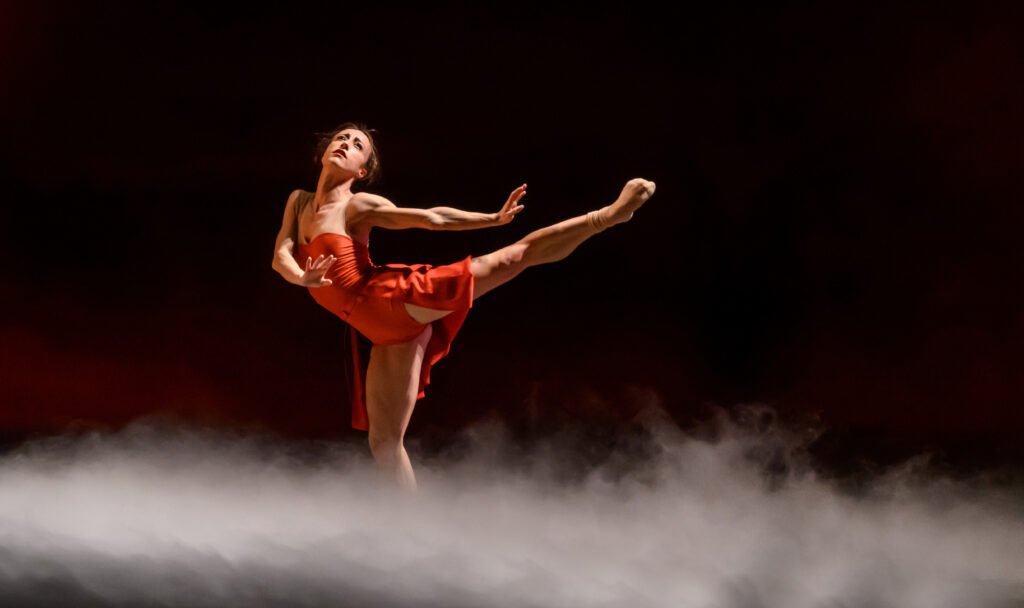Jessica Harris watches the latest Birmingham Royal Ballet production at the Hippodrome.
Six new works devised and produced by an all-female international creative team and inspired by some of Birmingham’s most pioneering and socially enterprising women. This is the kind of ambition that marks the city out as a place of collective drive and community-focussed aspiration.
Using the moon as a central motif, each movement in this two-act production focuses on themes relating to women. The works are abstract and yet the ideas they express are clear. Pieces by choreographer Wubkje Kuindersma frame the whole. The opening movement, Terra, explores the relationship between women and nature. The choreography has a wonderful fluidity to it, whilst a back-projection of the moon above a rolling sea, followed by a projection of trees with blue skies breaking through, emphasises the organic nature of this relationship.
The last movement, Luna, is set against images of the night sky. Orchestral music takes on a celestial tone, and a feeling of harmony prevails. The final image is one of dancers looking up towards the moon and the skies, and there is a sense that anything is possible.
The second movement, Learning to Dream Big, choreographed by Seeta Patel, explores the importance of education for girls and women. The five dancers hold books that are brilliantly illuminated as they are opened up. On the backdrop are the words, “When you educate a girl, you educate a nation”, and we are reminded that Birmingham became home to the remarkable Malala Yousafzai. As dancers represent potential career trajectories of women who are educated, this is the most explicit of the pieces, and some of its ideas are repeated in a slightly overlong ending.
Unwavering (choregraphed by Thais Suarez) in Act One and Overexposed (choreographed by Iraxte Ansa) in Act Two deal with themes of adversity and female oppression. Beatrice Parma, Birmingham Royal Ballet’s newly promoted Principal Dancer, dances in both, her performance beautifully expressive and expansive. Unwavering ends with the stunning image of her rising phoenix-like against the backdrop of a harvest moon. Overexposed is possibly the most enigmatic of all the works: Parma, as the lone female, dances with masked male dancers, and the sense of threat is palpable.
Empowerment, choreographed by Arielle Smith, shifts the pace. Frenzied and tempestuous, it is accompanied by an orchestral soundscape. It speaks of the challenges faced by women and of the way they support each other to overcome them. In choreographic terms, it could have pushed the theme a little further. Yet the final image of women leaping high is strong.
Music by Kate Whitley, performed by the Royal Ballet Sinfonia, is rich and varied. Several pieces are accompanied by two singers, soprano and baritone, which add to the drama of the works. A choir of 30 children, supported by Ex Cathedra, gives further effect. They make use of the full stage and, at times, carry brightly lit globes which underpin the lunar theme.
Video projections by Hayley Egan and lighting by Emma Jones create atmosphere and add layers of meaning to the pieces, and projections of the words of inspirational women add context.
Occasionally, there is just a little too much taking place on stage, particularly when the final movement seeks to incorporate elements of all of the previous pieces. But, taken as a whole, this latest production by Birmingham Royal Ballet is marked by the vision and creativity of Birmingham Royal Ballet’s Artistic Director, Carlos Acosta. It is the final part of his Birmingham Trilogy, which included City of a Thousand Trades and Black Sabbath – The Ballet. It is truly worth seeing.
It is on at the Hippodrome until 5th October. For further information visit birminghamhippodrome.com
Pics – Katja Ogrin.
